
We compared the "Jet Boil" to see how amazing the "MSR Windburner Personal Stove System" is, with its overwhelming thermal efficiency and strength against wind.
The MSR Windburner is an all-in-one, single-person high-efficiency stove system that incorporates groundbreaking mechanisms. Although it has already been on sale in North America for several years, it has not been sold for a long time due to restrictions, and has caused a stir to the core mountain fans, but in the 2020 season, it has finally been officially sold, and has become a bit of a hot topic in the community.
Jet Boil is the forerunner of such a stove system that combines pots and stoves I've been using that for a long time, and how much more effective is this model compared to that? Is it a "buy"? I've always wanted to check it out for myself, and the time has finally come.
So, this time we used this model in the actual field and compared the water boiling conditions under the same conditions as the Jetboil MiniMo In fact, this product has been released in its home country of America for six years, but we will report on why it is becoming a hot topic right now, as well as how it has been tried in various environments.
*The test results and evaluations this time are not formal performance evaluations of the product, but are results and evaluations based on certain conditions and operations as envisaged by the reviewer. We do not guarantee the results under other conditions, and please make your own judgment regarding all results and evaluations at your own risk.
table of contents
Main features of the MSR Windburner Personal System
MSR's wind burner personal system is a high-performance, highly efficient all-in-one burner system that can be used stably even in strong winds and low temperatures. By adopting a radiant burner mechanism, which is rare for outdoor burners, it achieves high thermal efficiency and high wind resistance. The special pot (pot) can store everything you need, such as the burner itself and gas can, making it extremely compact and portable. The pot capacity is 1L, so it can be used for mountain hiking, not only for one person but also for two people.
Windburner specs and ratings
| item | Specifications and ratings |
|---|---|
| This is ◎ |
|
| This is △ |
|
| Burning power | ★★★★★ |
| Wind resistant | ★★★★★ |
| Combustion efficiency | ★★★★★ |
| Storageability | ★★★★★ |
| Easy to use | ★★★☆☆ |
| Versatility | ★★★☆☆ |
| weight | ★★★★☆ |
| Actual measured weight | 468g (excluding gas cartridges) |
| Maximum output | 1765kacl/h |
| capacity | 1.0L |
| Contents (individually measured weight) | Main body (198g) Pot (207g) Cap (14g) Stabilizer (17g) Cup (32g) |
| Storage size | 11.5 x 10.7 x 18.1cm |
Detailed review
The wind burner consists of the burner body, pot (1L), cup (360ml), cap, stabilizer and towel. This will be accompanied by a special gas can (sold separately), and all items will be 7.
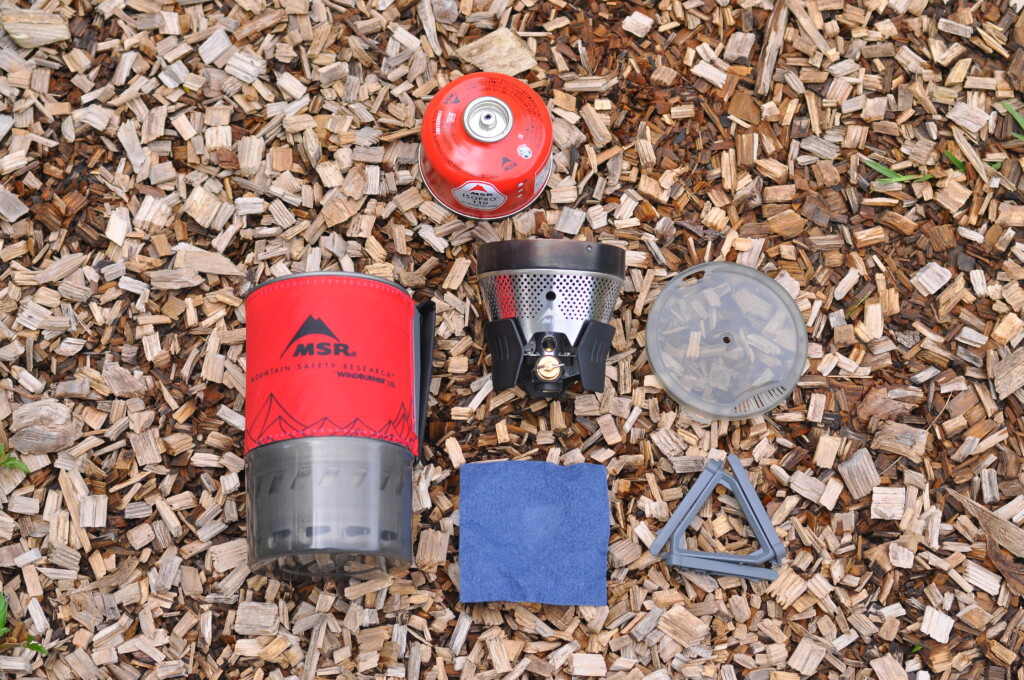
Contents + gas can (110)
All contents can be stored in a 1L pot.
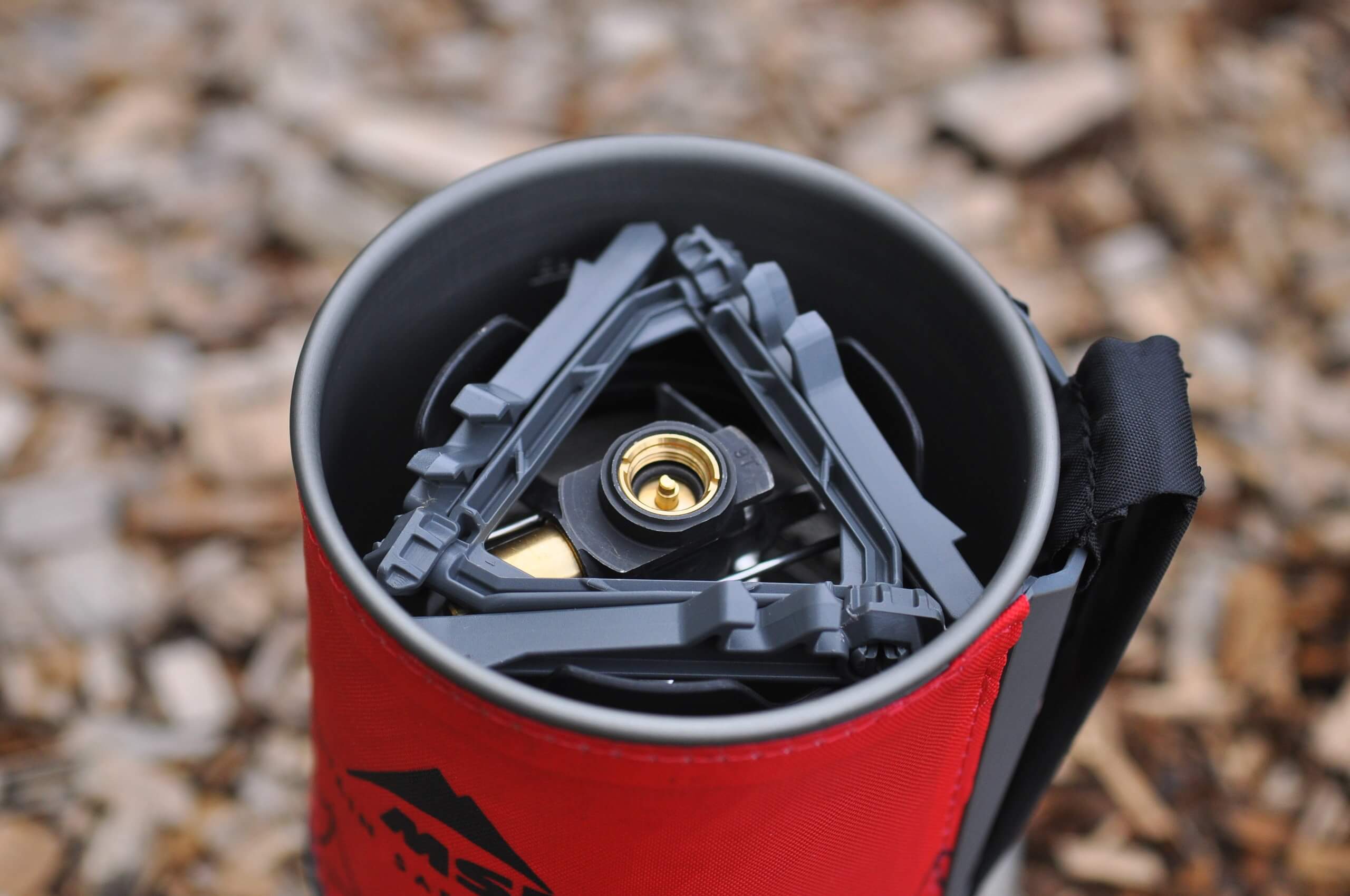
All contents, including gas can, can be stored in a pot
It can be stored all in one place, making it compact and you can prepare it without any stress when cooking, making it very easy to pack.
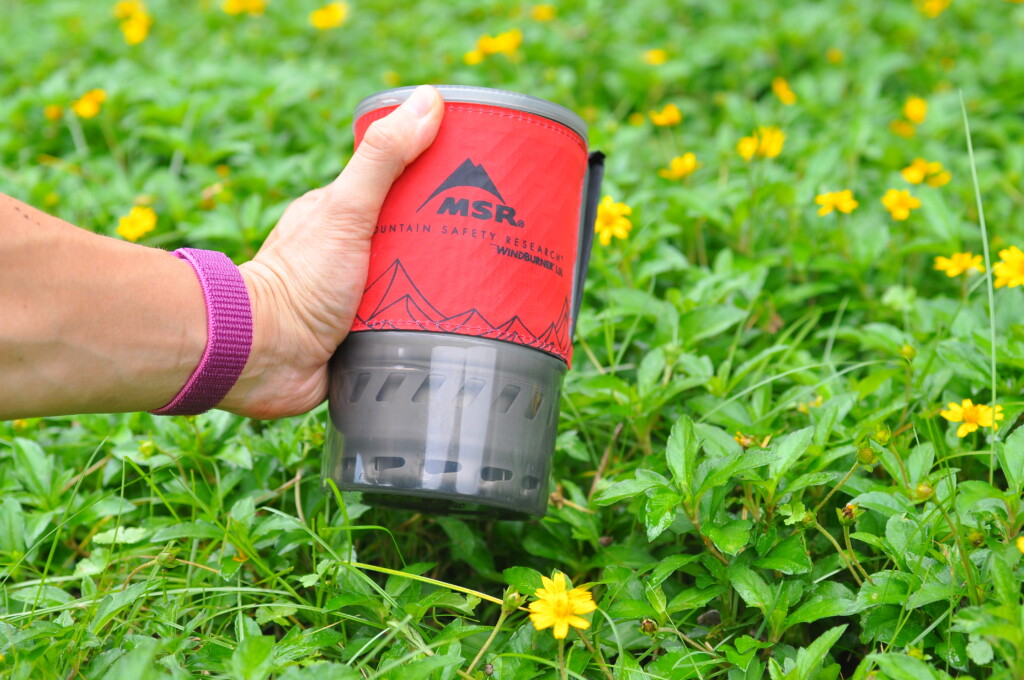
Can be stored compactly
When stored, it is stored in the pot like this:
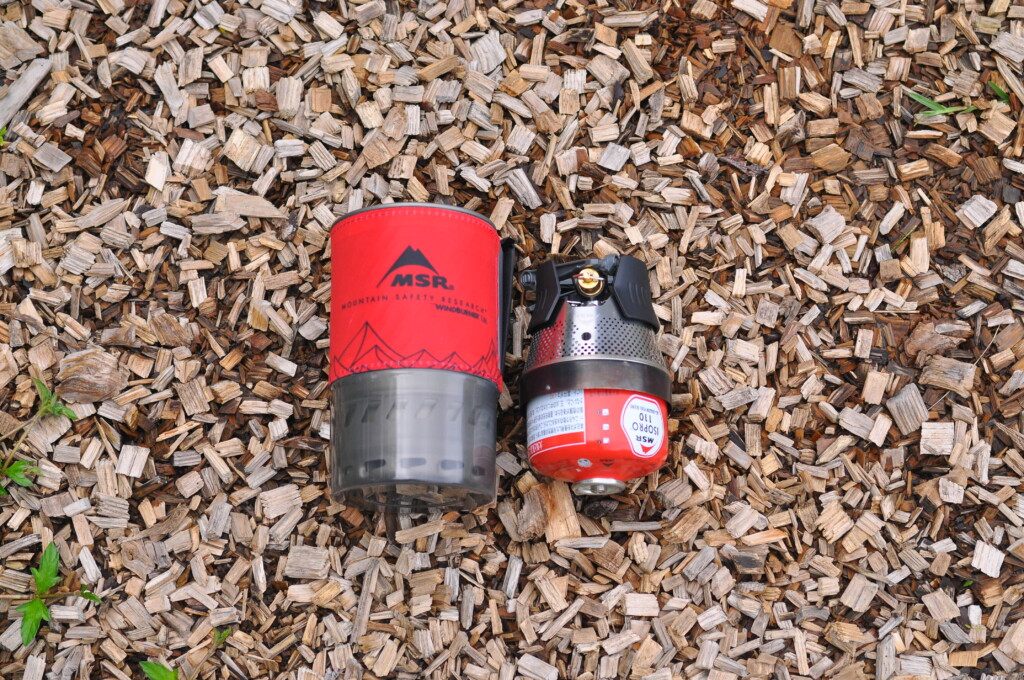
It's stored in the pot like this
When assembled, it is approximately 32.5cm from the ground, which is longer than expected and slightly less stable, so it is better to use the included stabilizer for the gas can.

Assembled state. Become taller than 30cm
From here, we'll look at the burner itself. The body has a very unique shape.

Uniquely shaped body
Viewed from above, the crater is quite large, with a finer mesh mesh underneath the metal mesh. When you set it on, the fire does not burn brightly like a regular burner, but rather the mesh heats up and the infrared rays emitted from it warm the pot.

It has a unique shape when viewed from above. At first glance, it doesn't look like a burner
When I actually light it, the mesh burns bright red and looks like it's hot. The maximum heat power in this state is dark, so you can see that it is on at a glance, but it is difficult to tell if it is on when the surrounding area is bright or low, so you can check whether it is on by checking whether the indicator you pass in a straight line is red or not.

The mesh turns bright red as soon as it is set on fire
Even if the surroundings are bright, you can somehow see that the indicator is red.
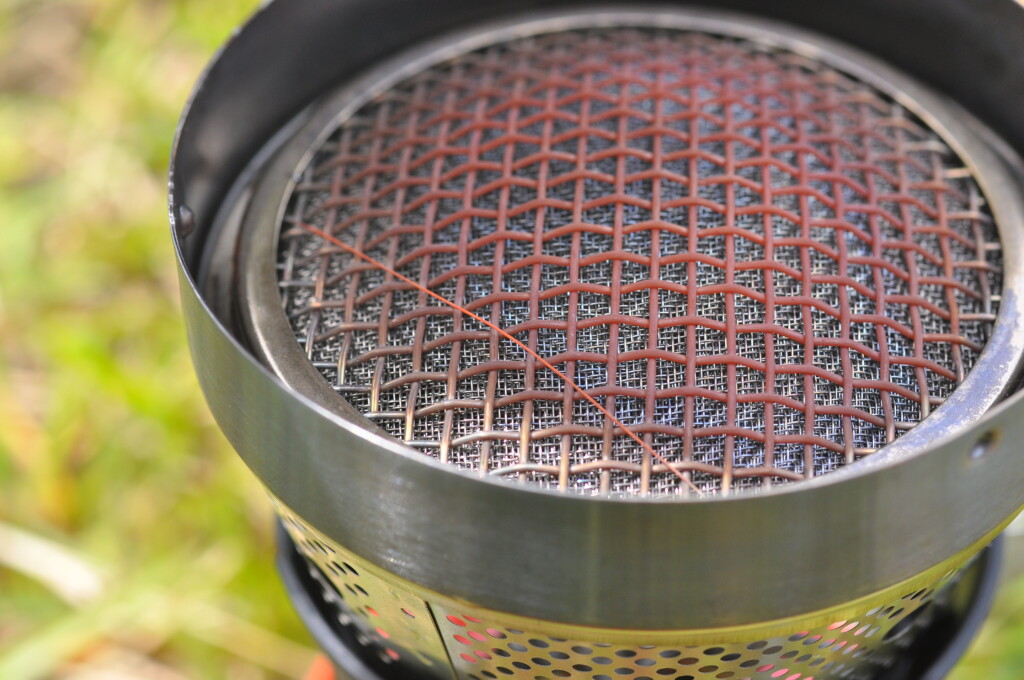
Even though the surroundings are bright, you can see that they are somehow red
This burner does not come with an igniter (ignition device), so you need to remember to bring a lighter, match, fire starter, etc. when using it. MSR burners often do not use igniters.
Once it's on fire, place the pot on. When the pot is placed on it, it is completely sealed and cannot be ignited, so it will ignite before placing the pot.

Fit the pot after it is ignited.
Once you put the pot on, you will notice that the crater is completely sealed. This allows you to transfer heat to the pot without waste, allowing you to boil water at high efficiency and high speed.

Once you put on the pot, you can see that the crater is sealed.
In addition, the back of the pot has a feather-like structure. This is a mechanism called a heat exchanger and serves two main functions. One is to efficiently transfer heat to the pot. The other is the sealed crater, which forces the carbon dioxide generated during combustion to prevent incomplete combustion, and also serves to place hot air in the air flow to heat the pot more efficiently.
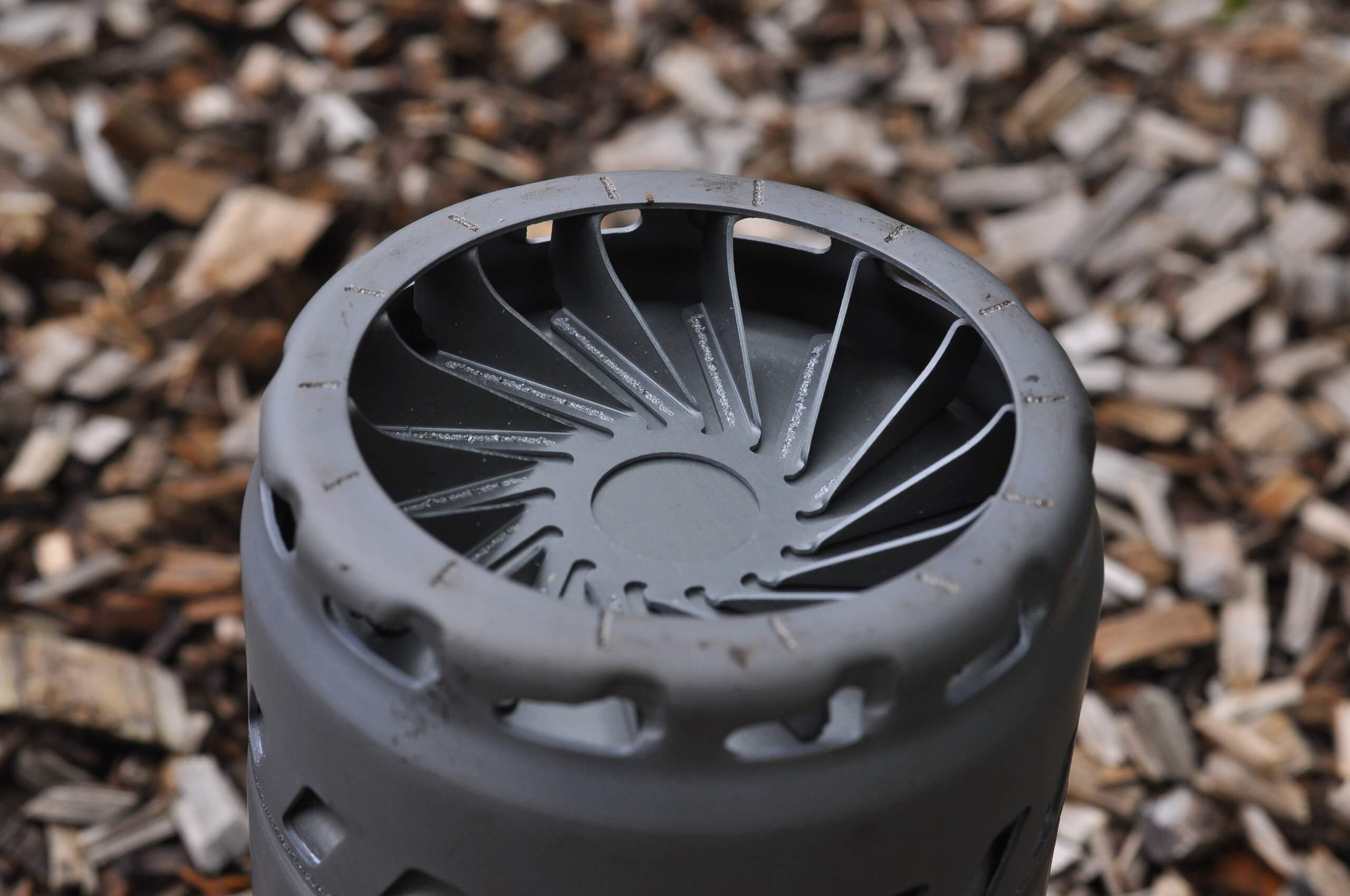
The bottom of the pot has a heat exchanger that efficiently transmits heat.
You can see that if you flush water from the back of the pot, it will come out firmly. This is probably where carbon dioxide is being released.
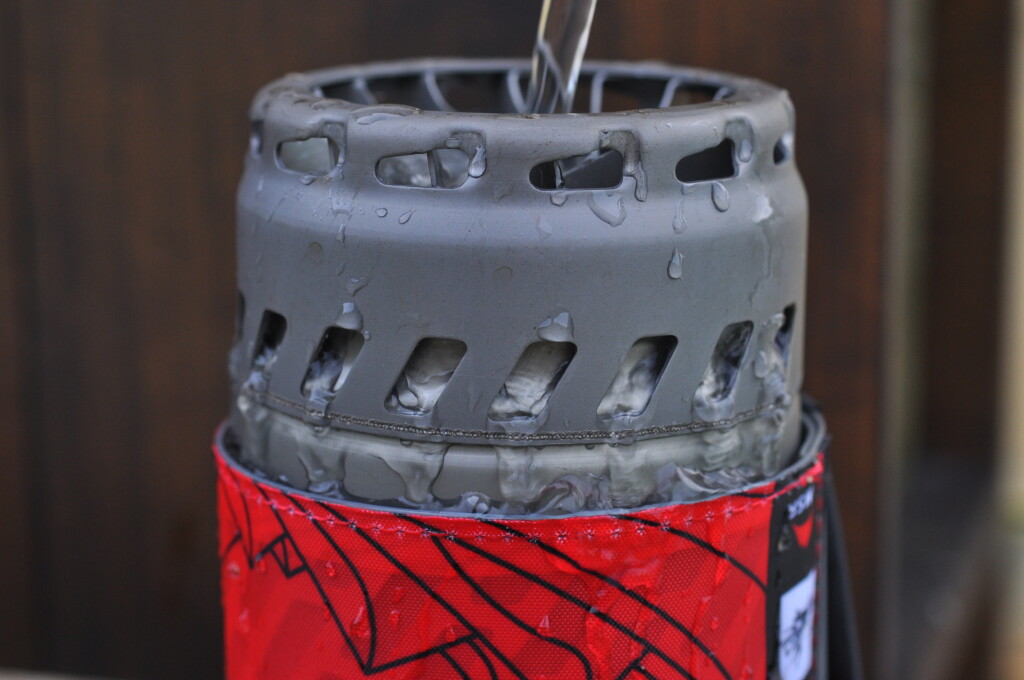
There is a ventilation vent, and carbon dioxide will flow out like water is leaving.
The above structure is called the radiant burner mechanism and is an essential structure for achieving high thermal efficiency and wind resistance. As shown in the diagram below, normal burners always require oxygen for the burning flame itself, so if windproofing is increased, sufficient oxygen will not be supplied and the combustion power will decrease. As a result, we had no choice but to have a structure that could supply oxygen, and we were inevitably weak to the wind. However, since windburners can supply all oxygen with only primary air, even if they are completely prevented from wind, they will not cause incomplete combustion (from the official MSR website).
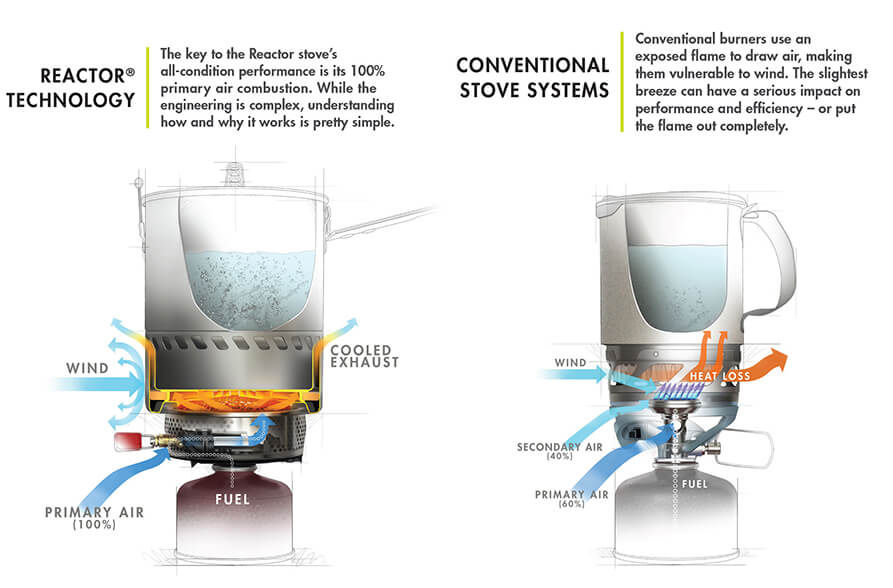
Quote: From the official MSR website
Now, let's go back to the product. There is memory inside the pot. The maximum capacity is 1000ml, but to prevent overflow, the maximum capacity is 600ml when boiling water. In fact, the pot scale is stamped Max on the 600ml location.

The scale is engraved to indicate the capacity
The red part of the pot is made of a resin frame with nylon fabric attached, and although it does not have high heat retention, it serves like a simple cozy. Thanks to this, you can hold it by hand unless it is boiled immediately. It also has a handle so you can hold it in your hand without any problems even after it boils.
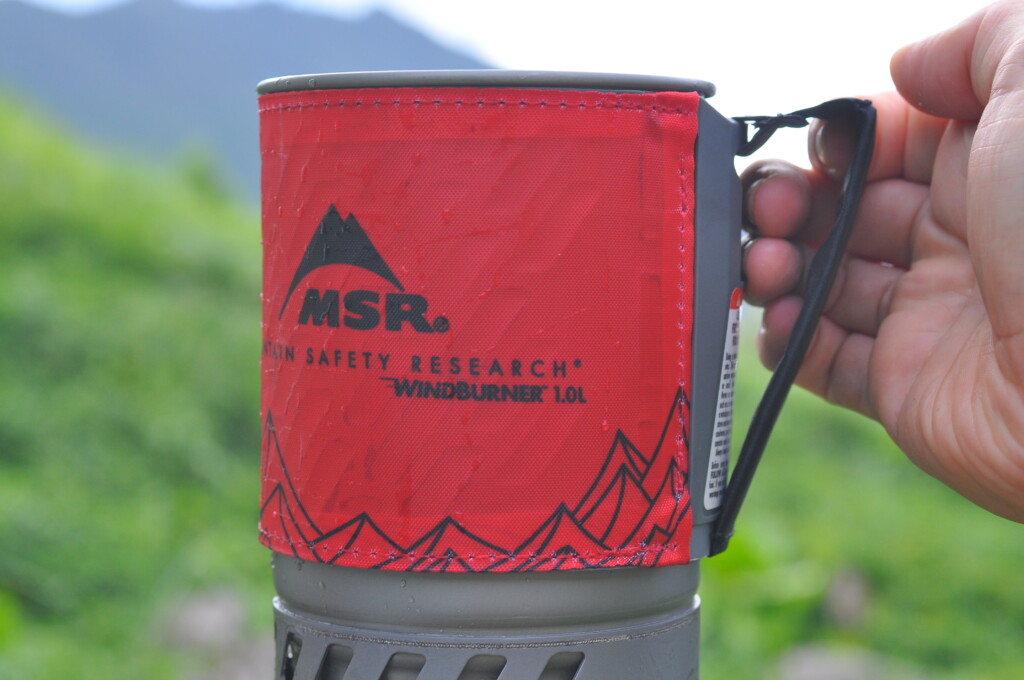
There is a handle so you can lift it even after it boils
This part can be removed and is easy to dry and clean, making it hygienic.

The material is not a problem even if it gets wet, but it can also be removed and washed.
The main purpose is to boil water, but you can also do simple cooking such as boiling and simmering noodles. The cap has holes for draining water, so cooking is easy.

The cap has holes that are convenient for draining water, making it convenient for cooking
The cup attached to the bottom of the pot when stored is heat resistant to 105°C, making it a dishware. The pot cap also fits the cup, so it can be used in a variety of ways, and if you are alone, you can reduce the number of dishes.

The cap can also be used in cups
Finally, let's take a look at the weight details. The official weight is 465g, and the actual measured weight was 468g, so there was no error. Looking at the individual items, there were 198g of the main body (burner), 207g of the pot, 32g of the cup, 14g of the cap, 17g of stabilizer, and 1g of towel (1.5g).
We tried to compare them under various conditions (wind banner & jet boiler)
Taking into consideration the actual environment used, we changed the amount of water, wind, temperature, etc. and measured the time it took to boil.
The conditions for each test are not strictly matched, and since the boiling timing was determined visually, not temperature, so there is an error of a few seconds, so this is only for reference only.
First, let's compare the basic specs of the two. The jet boiler is slightly lighter in weight.
| item | MSR Windburner | Jetboil MiniMo |
|---|---|---|
| Maximum output | 1765kacl/h | 1404kcal/h |
| capacity | 1.0L | 1.0L |
| Actual measured weight | 468g | 433g (Getty) |
| Contents (individually measured weight) | Main body (198g) Pot (207g) Cap (14g) Stabilizer (17g) Cup (32g) Towel (1g) | Main body (130g) Pot (199g) Cap (30g) Stabilizer (26g) Cup (48g) |
| Storage size | 11.5 x 10.7 x 18.1cm | 12.7cm x 15.2cm |
I measured the time it took to actually add water and boil. As mentioned above, we visually determine whether the boiling has reached a boil, so please be sure to take a look assuming that there is an error of a few seconds. The test was conducted between boiling between 500ml and 1000ml at room temperature, 500ml in the freezer to measure cold resistance, 500ml with a fan to measure wind resistance, and 500ml in a boiling area at high altitudes. Each condition is as similar as possible. The boiling was carried out five times at room temperature, and the average value was shown (hours are minutes: seconds).
| item | MSR Windburner | Jetboil MiniMo |
|---|---|---|
| Room temperature (almost no wind, no lids/no lids) 500ml (average 5 times) | 2:01 / 2:16 | 1:44 / 1:52 |
| Room temperature (almost no wind, no lid) 1,000ml (average 5 times) | 3:49 | 3:39 |
| Freezer 500ml | 3:09 | 3:07 |
| Fan (strong) 500ml | 2:25 | 2:39 |
| High (altitude about 2000m) 500ml | 1:45 | 1:27 |
| Combustion efficiency (Gas consumption per boiling of 500ml water) | 5.8g | 4.4g |
Room temperature (almost no wind)
I had predicted a certain amount of room temperature water (approximately 17°C) based on the official specifications of my home country, but the jet boiling time was slightly faster. The jet boiler, with the lid on the lid, is incredibly fast, at just 1 minute and 44 seconds.
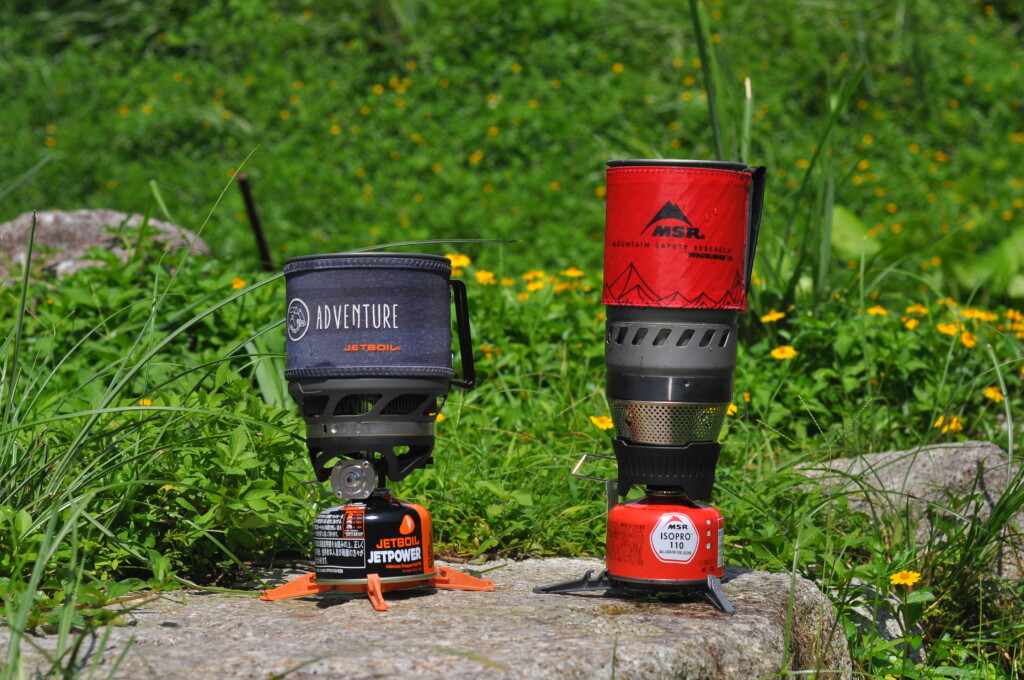
Measure the time until boiling under the same conditions
low temperature
Next is a boiling test at sub-zero temperatures, a field that is likely to be able to demonstrate the performance of windburners, which are said to be resistant to cold. However, the Jetboil Minimo also comes with a thermo regulator so that it can be used at low temperatures, so it's hard to know what will happen.
After putting each system (pot, burner, gas can) in the freezer for an hour in advance, I cooled it, then poured 500ml of room temperature water into a boil. Incidentally, just before the test started, the temperature inside the freezer was a wind burner (-15°C at start, -8°C at end), a jet boiler (-16°C at start, -10°C at end), and the freezer was kept below freezing.
The result was a windburner of 3 minutes 9 seconds and a jet boiler of 3 minutes 7 seconds, but the performance could be almost the same when considering the visual error. Considering the boiling time of jet boiling in room temperature tests as a standard, its performance at low temperatures seems to drop sharply.
Strong wind
Now, as you would expect, this burner is characterized by its wind resistance. What about actual measurements? I tried measuring it by directly hitting the fan with wind. I haven't measured the wind speed, so this is the performance for this level of wind. That's not to be said, but I tested it with a strong fan mode.

A fan was installed to test wind resistance. The jet boiler is raised to match the height of the crater.
When I hit the wind in strong mode away from the stove, the wind burner was 2 minutes 25 seconds and the jet boiler was 2 minutes 39 seconds, and as I imagined, the wind burner was able to boil faster. As it is said to be wind-resistant, the wind burner boiled about 10 seconds later than the results of the room temperature test, but the jet boiler was about 45 seconds later than the results of the room temperature test, and the wind was clearly affected.
[Additional note] Additional test for strong winds: Under more severe conditions, the difference in wind resistance is clearly visible
In order to replicate the situation in the mountains, it seemed a little weak in the wind from the fan, so I decided to do an additional test here in a slightly more severe environment. We once again conducted a boiling test using an anemometer under two conditions: 3.5m/s and 4.5m/s and 4.5m/s.
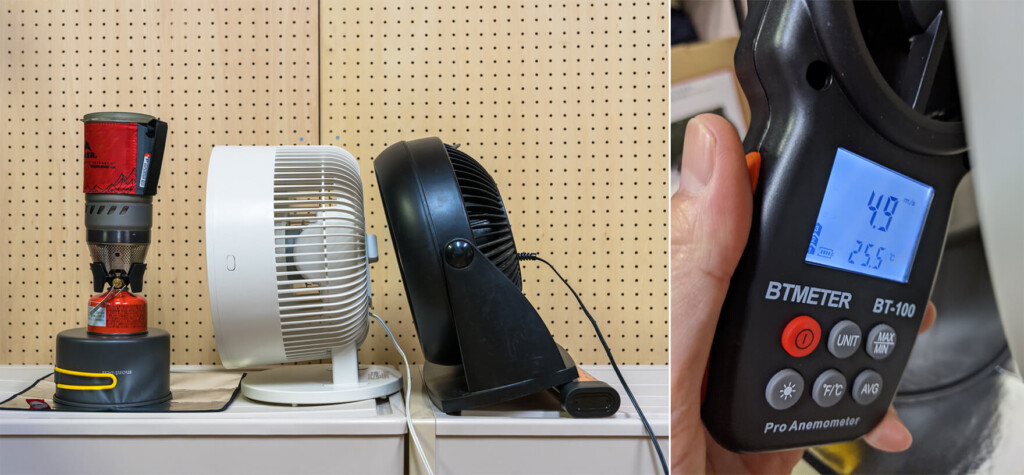
The circulator wind was hit directly on the stove, and the wind speed in that area was measured to match the conditions. Since the limit for one unit was 3.5m, we added another circulator and managed to get wind speeds from around 4.5 to 5.0m.
However, as shown in the photo above, the wind uses a household circulator that is stronger than a fan (for this reason, the wind speed was limited to 4.5m), and anemometers are generally sold for several thousand yen, so they do not have the precision of a managed lab test. Therefore, the results in actual fields may not be the same as those in the test. However, this was created because there were clear differences in use, so we will share the test data for reference.
| item | MSR Windburner Wind Speed Approx. 3.5m | Jet Boil MiniMo Wind Speed Approx. 3.5m | MSR Windburner Wind Speed Approx. 4.5m | Jet Boil MiniMo Wind Speed Approx. 4.5m |
|---|---|---|---|---|
| Boiling time (m:s) | 2:10 | 4:10 | 2:12 | It doesn't boil completely |
| Gas Consumption (g) | 7 | 11 | 7 | Can't measure |
As you can see from the results above, no matter how strong the wind speed is, at 3.5m/s and 4.5m/s, the windburner performs almost the same as normal, while the jet boiler managed to boil at a wind speed of 3.5m/s, but it was unable to boil completely at a wind speed of 4.5m/s.
To be more precise, the jet boiler at a wind speed of 4.5m/s seemed to boil on the other side of the wind hit in about 5 minutes, but no air bubbles from the boiling appeared on the side where the wind hit, and the entire container was boiling, so it was impossible to reach the point where it was in full boiling. In the real field, these windy conditions are fully considered, so there is likely a clear advantage here for Windburner.
Of course, since the test was conducted under somewhat rough conditions, there is a good chance that there will be some distortion in the results, but I still can't believe the difference will be so large. Jet boilers tend to have a boiling time that changes depending on the conditions, and in peace, the boiling time is shorter and gas consumption is low, but if you plan your equipment to take into consideration the use of the jet in more harsh conditions, it is honestly unclear whether it can actually be said to have an advantage. Rather, this high stability of the windburner can be said to make fuel planning easier and safer.
High (approx. 2000m above sea level)
We also conducted a boiling test on a mountain that is about 2000m above sea level. On this day, there was almost no wind and no effect from the wind.
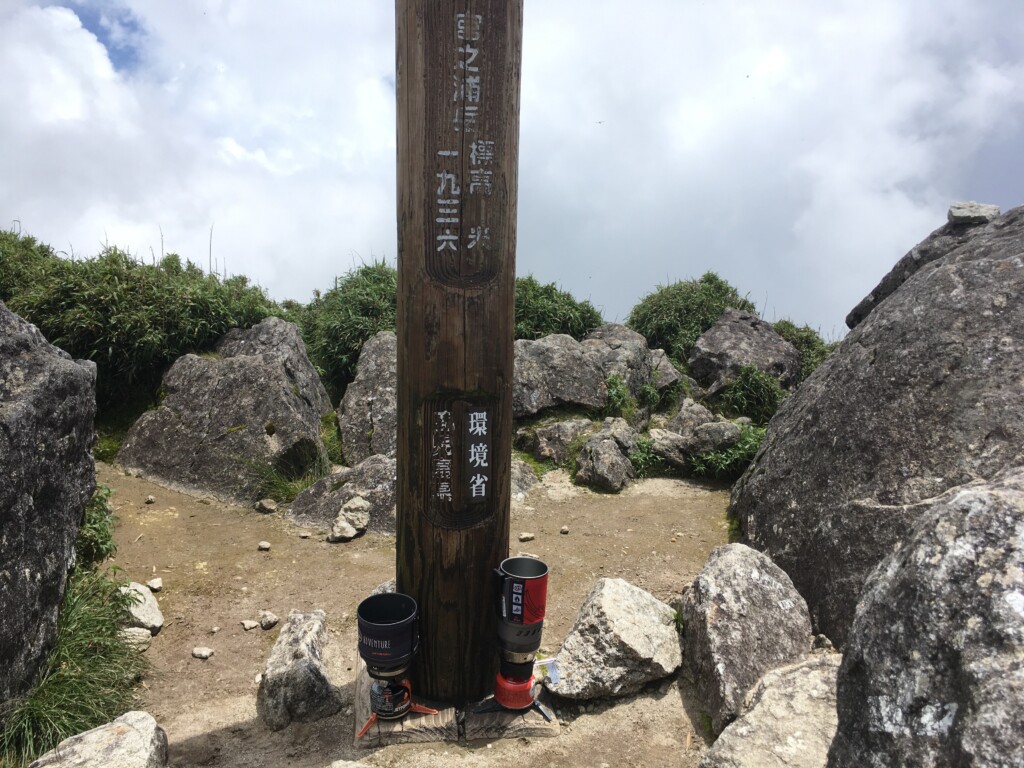
Tested at 2000m above sea level
The windburner was 1 minute 45 seconds and the jet boiler was 1 minute 27 seconds, making the jet boil faster, just as at room temperature at about 2000m. The reason the boiling earlier than during the test in the outside world is that the water temperature was slightly higher, the high temperature in the village on the day was 30°C, and the boiling at about 94°C at an altitude of 2,000m due to atmospheric pressure.
Combustion efficiency
It is clear that jet boilers have a slightly superiority in the official specifications, but to see this too, we boiled 500ml of water at room temperature using the smallest gas can from each manufacturer, measured the weight of the gas can each time, and estimated how much 500ml of water can be boiled in one can based on the amount of gas it has decreased.
The dedicated 110-size can of Windburner has a gas filling capacity of 110g, and after boiling it five times, the average amount of gas used per boil is 5.8g. Considering that the gas will run out when removing the burner and gas can, it is likely that one can bring it to a boil about 18 times. Meanwhile, Jet Boil's dedicated Jet Power 100G gas can fill 100g, with an average gas usage of 4.4g every five times. This too, taking into account the gas leak when removing it, the estimated number of boils in one can be 22 times. Although both are basically extremely efficient, the most efficient one seems to be jet boilers.
summary
For those who have been waiting for a long time, I've always wanted to see it! It's a tool that can be said to be true. Those who are like that have already purchased it without looking at the reviews. This burner has been waiting for so many people. It is true that looking at the results of the boiling test, the Jetboil MiniMo was higher and better in terms of performance in peaceful places and situations. However, from testing, we can see that wind burners deliver the same performance as jetboil, which reduces performance in harsh environments such as low temperatures, strong winds, and high altitudes.
As I mentioned above, it is not uncommon for situations that are windy than you imagined in the actual field, and it is often the case that people want to consume warm foods are in a very severe environment and physical situation. In the midst of all this, there are probably many people who have experienced a scene where the water never boils and gets anxious. Not only are the hard activities that come with high ground, strong winds and low temperatures like winter mountains, but also long-term traverses that are prone to bad weather and activities that require you to stay in a tent in a tough place, and for those looking for tough tools that can be used safely anytime, anywhere, this will likely be a more reliable partner than a jetboil.
When you think about the type of environment you will use it, you will naturally be able to see which one to buy. Jetboil may be fine for people who don't do such a hard climb, but if you're looking for a fairly hard climb, you'll probably want to choose toughness and stability (and personally, how cool the look is). In any case, windburners are a highly anticipated and powerful option for mountain enthusiasts, in the field of system burners, which has long been a limited choice.



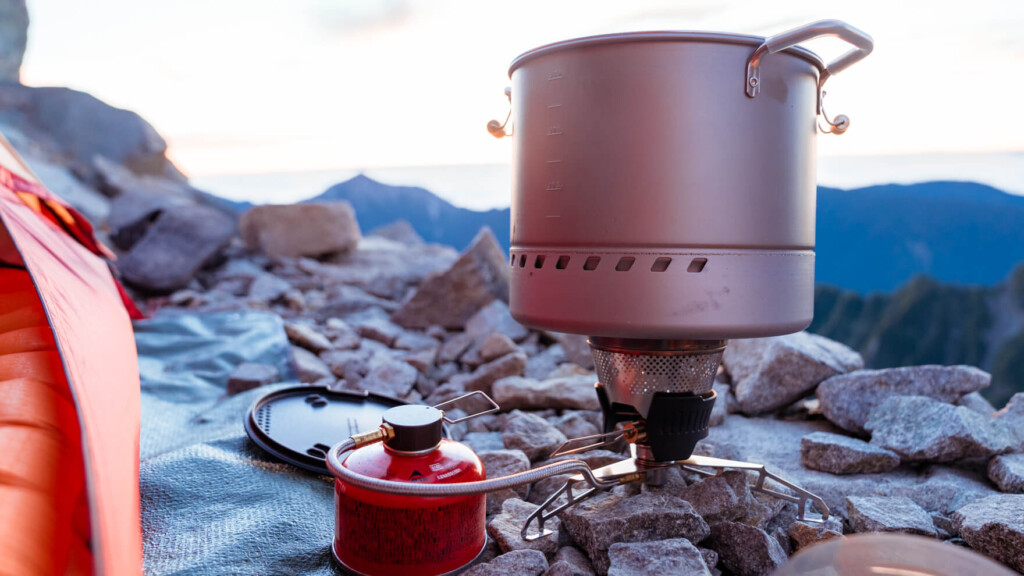 This is a great item that I recommend this year. The "MSR Low-down Remote Stove Adapter" instantly creates a lightweight, small gas stove that can be used as a group cooking style.
This is a great item that I recommend this year. The "MSR Low-down Remote Stove Adapter" instantly creates a lightweight, small gas stove that can be used as a group cooking style. Mountain gas stoves (burners): Best buys for each type that you can understand when you actually use them, and 5 tips to choose them wisely
Mountain gas stoves (burners): Best buys for each type that you can understand when you actually use them, and 5 tips to choose them wisely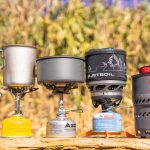 Comparison Review: Which gas stove should you choose for your mountaineering? I compared it
Comparison Review: Which gas stove should you choose for your mountaineering? I compared it [Comparison review without any consideration] Which is the best time to buy PRIMUS' "Single Burner for Mountaineering" now? Comparing it in the actual field [A surprising result]
[Comparison review without any consideration] Which is the best time to buy PRIMUS' "Single Burner for Mountaineering" now? Comparing it in the actual field [A surprising result]